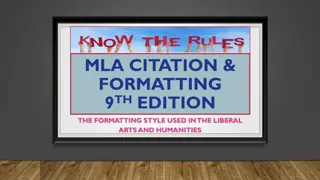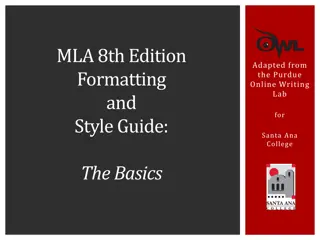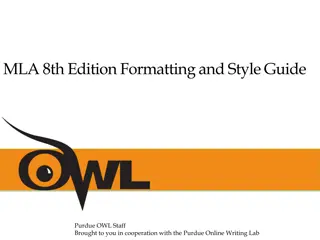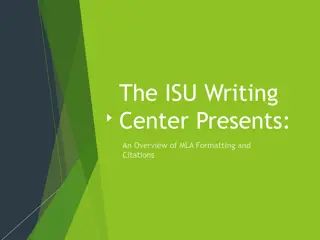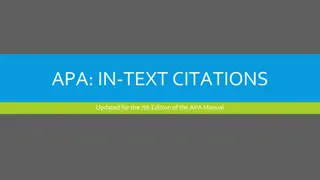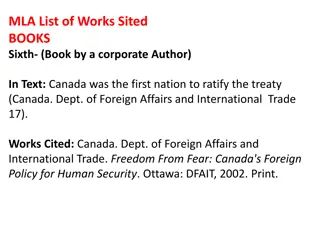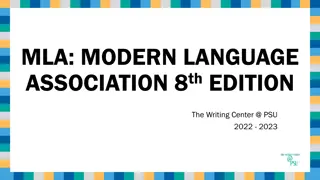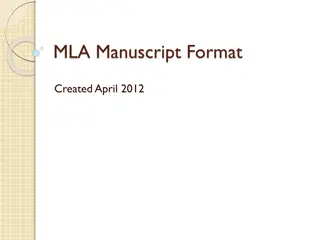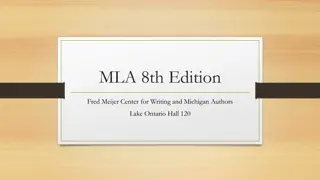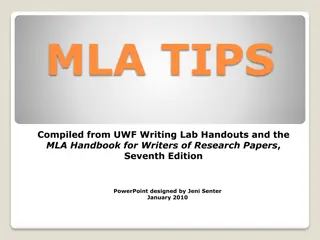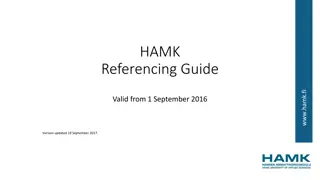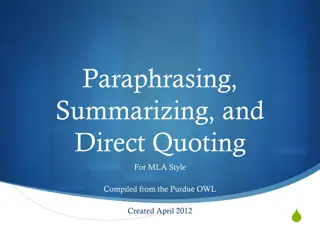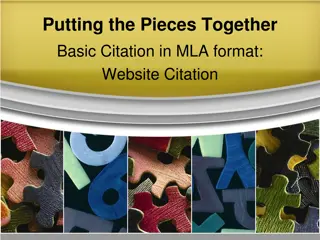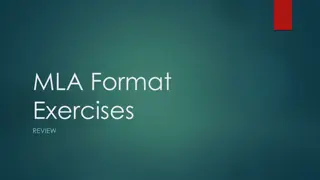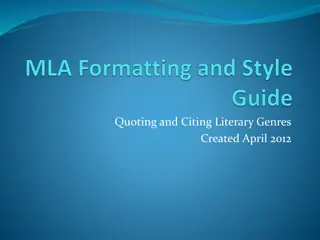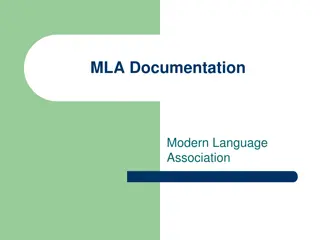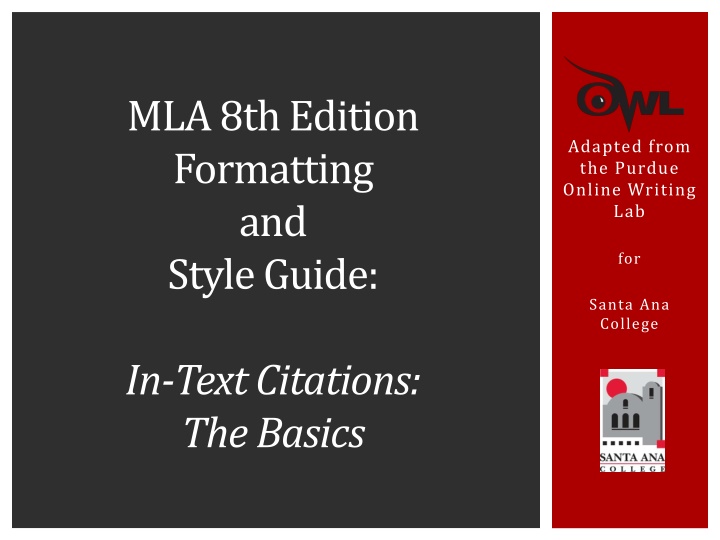
MLA In-Text Citations and Plagiarism Avoidance
This resource provides a comprehensive overview of incorporating in-text citations in MLA documented research assignments, the importance of citations to a Works Cited page, what information to cite, ways to create in-text citations, understanding plagiarism, and utilizing resources like the Purdue OWL. It emphasizes the basics of in-text citations, including when to cite, what constitutes common knowledge, and where to place citations within the text to maintain academic integrity.
Download Presentation

Please find below an Image/Link to download the presentation.
The content on the website is provided AS IS for your information and personal use only. It may not be sold, licensed, or shared on other websites without obtaining consent from the author. If you encounter any issues during the download, it is possible that the publisher has removed the file from their server.
You are allowed to download the files provided on this website for personal or commercial use, subject to the condition that they are used lawfully. All files are the property of their respective owners.
The content on the website is provided AS IS for your information and personal use only. It may not be sold, licensed, or shared on other websites without obtaining consent from the author.
E N D
Presentation Transcript
MLA 8th Edition Formatting and Style Guide: Adapted from the Purdue Online Writing Lab for Santa Ana College In-Text Citations: The Basics
AFTER THIS WORKSHOP I WILL Understand the basic elements required to incorporate in- text citations in an MLA documented research assignment Understand the relationship to and the importance of in- text citations to a Works Cited page in a research assignment Know what information I should and should not cite Know the different ways that I can create in-text citations Know what plagiarism is and how to avoid it Search for information regarding MLA in-text citations by using the OWL at Purdue Use Microsoft Word to create my own properly formatted MLA paragraph, essay, and research paper
In-Text Citations: the Basics An in-text citation is a brief reference in your text that indicates the source you consulted. It should direct readers to the entry in your works-cited list for that source. It should provide the citation information without interrupting your own text. In general, the in-text citation will be the author s last name (or abbreviated title) with a page number enclosed in parentheses.
What Should I Cite? Did you: Look at or speak to a source? (Google, website, professor, book, magazine, YouTube, etc.) If you said yes to this question, you should include an in-text citation. Ask yourself: Is this information something most people would know? If you answer no to this question, you should include an in-text citation. When in doubt, CITE!
What is Common Knowledge? Broadly speaking, common knowledge refers to information that the average, educated reader would accept as reliable without having to look it up. This includes: Information that most people know, such as Earth is the third planet from the sun or that Barack Obama was the first American of mixed race to be elected president. Information shared by a cultural or national group, such as the names of famous heroes or events in the nation s history that are remembered and celebrated. However, what may be common knowledge in one culture, nation, academic discipline, or peer group may not be common knowledge in another. When in doubt, CITE! What is Common Knowledge? Academic Integrity at MIT: A Handbook for Students, integrity.mit.edu/handbook/citing- your-sources/what-common-knowledge. Accessed 17 Aug. 2018.
Where Should I Cite? Summaries, paraphrases, and direct quotations require citations within the text of your papers. Without including citations in these circumstances, students risk plagiarism. Plagiarism is presenting the ideas or exact words from a source as your own without proper citation. To avoid plagiarism, be sure to use the citation style required by your professor.
How Should I Cite? Signal Phrases and Parentheticals Information which is borrowed or quoted directly from a source will require a signal phrase, a parenthetical, or both if the source uses page numbers. A signal phrase is used to set up or lead into quoted or borrowed information. Some examples include: The author notes ... writes the director, Howard Hughes. Witnesses claimed Evidence in a study by Purdue University concludes
How Should I Cite? Signal Phrases and Parentheticals A parenthetical ends a sentence that contains borrowed information or direct quotes. The type of source and information available indicate what will be included in a parenthetical but will always correspond exactly with the first element listed on the Works Cited page. Parentheticals include: Source s author s last name, if available (Twain) Source s page number, if available (Twain 22) Source s title if there is no known author ( Painting Fences: A Tall Tale )
Author-Page Style In-text Example: Wordsworth stated that Romantic poetry was marked by a spontaneous overflow of powerful feeling (263). Romantic poetry is characterized by the spontaneous overflow of powerful feelings (Wordsworth 263). Wordsworth extensively explored the role of emotion in the creative process (263). Works Cited Entry: Wordsworth, William. Lyrical Ballads. Oxford UP, 1967.
Print Source with Author If the essay provides a signal word or phrase usually the author s last name the citation does not need to also include that information. Works Cited Entry: Burke, Kenneth. Language as Symbolic Action: Essays on Life, Literature, and Method. U of California P, 1966.
With Unknown Author How to cite a work with no known author: We see so many global warming hotspots in North America likely because this region has more readily accessible climatic data and more comprehensive programs to monitor and study environmental change. . . ( Impact of Global Warming 6). Corresponding Entry in the List of Works Cited: The Impact of Global Warming in North America. Global Warming: Early Signs. Penguin Press, 1999.
Other In-Text Citations Work by Multiple Authors In-text Examples: Smith et al. argues that tougher gun control is not needed in the United States (76). The authors state, Tighter gun control in the United States erodes Second Amendment rights (Smith et al. 76). A 2016 study suggests that stricter gun control in the United States will significantly prevent accidental shootings (Strong and Ellis 23).
Other In-Text Citations Sources without page numbers In-text Example: Disability activism should work toward creating a habitable space for all beings (Garland-Thomson). Corresponding Works Cited Entry: Garland-Thomson, Rosemarie. Habitable Worlds. Critical Disability Studies Symposium. Feb. 2016, Purdue University, Indiana. Address.
Formatting Short Quotations in Prose Short prose quotations In-text Example: According to Foulkes's study, dreams may express profound aspects of personality (184). Is it possible that dreams may express profound aspects of personality (Foulkes 184)?
Formatting Long Quotations in Prose: Block Quotes Quotes longer than four lines become block quotes In-text Example: Nelly Dean treats Heathcliff poorly and dehumanizes him throughout her narration: They entirely refused to have it in bed with them, or even in their room, and I had no more sense, so, I put it on the landing of the stairs, hoping it would be gone on the morrow. By chance, or else attracted by hearing his voice, it crept to Mr. Earnshaw's door, and there he found it on quitting his chamber. Inquiries were made as to how it got there; I was obliged to confess, and in recompense for my cowardice and inhumanity was sent out of the house. (Bronte 78)
Adding/Omitting Words In-Text Example for Adding Words: Jan Harold Brunvand, in an essay on urban legends, states, Some individuals [who retell urban legends] make a point of learning every rumor or tale (78). In-Text Example for Omitting Words: In an essay on urban legends, Jan Harlod Brunvand notes that some individuals make a point of learning every recent rumor or tale. . . and in short time a lively exchange of details occurs (78).
WHERE DO I GO TO REVIEW OR LEARN MORE? The best open (free) source with information about MLA in-text citations is the Online Writing Lab from Purdue University, more commonly known as OWL. Their website can be accessed through the url: https://owl.purdue.edu/owl/purdue_owl.html
WHERE DO I GO TO REVIEW OR LEARN MORE? Choose The Purdue Online Writing Lab Next, select MLA Guide and then General Format under the MLA Formatting and Style Guide menu.
WHERE DO I GO TO REVIEW OR LEARN MORE? Click on the MLA Formatting and Style Guide. Select the MLA In-Text Citations: The Basics from the dropdown menu for more details about using in-text citations.
NOW YOU Understand the basic elements required to incorporate in- text citations in an MLA documented research assignment Understand the relationship to and the importance of in- text citations to a Works Cited page in a research assignment Know what information you should and should not cite Know the different ways that you can create in-text citations Know what plagiarism is and how to avoid it Can search for information regarding MLA in-text citations by using the OWL at Purdue Can use Microsoft Word to create your own properly formatted MLA paragraph, essay, and research paper.
WORKS CITED What is Common Knowledge? Academic Integrity at MIT: A Handbook for Students, integrity.mit.edu/handbook/citing- your-sources/what- common-knowledge. Accessed 17 Aug. 2018. The Purdue OWL Family of Sites. The Writing Lab and OWL at Purdue and Purdue U, 2008, owl.english.purdue.edu/owl. Accessed 17 Aug. 2018.


